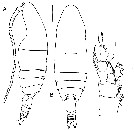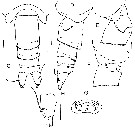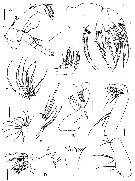|
|
 |
Fiche d'espèce de Copépode |
|
|
Calanoida ( Ordre ) |
|
|
|
Clausocalanoidea ( Superfamille ) |
|
|
|
Aetideidae ( Famille ) |
|
|
|
Prolutamator ( Genre ) |
|
|
| |
Prolutamator pseudohadalis Markhaseva & Renz, 2019 (F) | |
| | | | | | | Ref.: | | | Markhaseva & Renz, 2019 (p.220, Descr.F, figs.F, Rem.) |  Issued from : E.L. Markhaseva & J. Renz in Arthropoda Selecta, 2019, 28 (2). [p.221, Fig.5, A-B, I). Female (from Kurile-Kamchatka): A-B, habitus (lateral and dorsal, respectively); I, P1. Scale bars: 0.1 mm. Nota: - Prosome 3.2-3.4 times as long as urosome. - Rostrum absent. - Cephalosome and pediger 1 incompletely separate, pedigers 4 and 5 completely separate. - Posterior corners of prosome in dorsal view oval, in lateral view rounded. - Urosome 4-segmented. - A1 24-segmented, reaching posterior border of genital double-somite. - P1: coxa with medial spinules; basis with medial spinules, small lateral spinule distally and medial distal curved seta with setules; endopod 1-segmented with lateral lobe, its lateral margin with spinules, posterior segment surface with few tiny spinules; exopod segment 1 to 3 with 1 long lateral spine each, spine of exopod segments reaching nearly to the distal third of the following spine, spine of exopod segment 2 reaching the first third of the following spine. - P5 absent.
|
 Issued from : E.L. Markhaseva & J. Renz in Arthropoda Selecta, 2019, 28 (2). [p.221, Fig.5, C-H). Female: C-D, posterior corners of prosome and urosome (dorsal and lateral, respectively); E-F, posterior corners of prosome and genital double-somite (lateal view)G, genital field (ventral view); H, caudal ramus (ventral view). Scale bars: 0.1 mm. Nota: - Spermathecae upturned, very narrow, in ventral view not visible. - Caudal rami with 1 dorsal seta, 1 ventral seta and 4 terminal setae.
|
 Issued from : E.L. Markhaseva & J. Renz in Arthropoda Selecta, 2019, 28 (2). [p.222, Fig.6). Female: A2 (dotted line marks setae added after paratype); B, Md palp; C, cutting edge of Md gnathobase; D, Mx1 (praecoxal arthrite, coxal endite and epipodite, arrow marks small proximal posterior praecoxal arthrite seta; E, Mx1, praecoxal arthrite (arrow marks small proximal posterior seta); F, Mx1, basal endites, endopod and ewopod (setae of endopod not figured); G, Mx1, distal part of endopod with setae; H, Mx2; I, Mxp. A-D, F-I: holotype; E, paratype; Scale bars: 0.1 mm. Nota: - A2: coxa with 1 seta; basis with 2 setae; exopod 8-segmented (setal formula: 1-1, 1-1, 1, 1, 1, 1, 1, 3); 1st endopodal segment with 2 setae, 2nd segment with 8 + 7 setae. - Md: gnathobase with 5 large and 3 small teeth near dorsal seta; basis with 2 setae; exopod 5-segmented with 1, 1, 1, 1, 2 setae; endopod segment 1 with 1 seta, segment 2 with 6 setae. - Mx1: praecoxal arthrite with 9 terminal, 4 posterior and 1 anterior setae, one posterior seta small; coxal endite with 4 setae; coxal epipodite with 6 setae; proximal basal endite with 3 setae, distal basal endite with 5 setae; endopod with 15 setae; exopod with 11 setae. - Mx2: praecoxal endite with 3 setae; coxal endite with 3 setae; basal endites with 3 setae each, all endites decorated with thin denticles; enditic-like lobe of proximal endopodal segment with 3 setae, one seta thicker, spine-like; endopod with 6 long and 2 thinj small setae. - Mxp: syncoxa with 1 seta on proximal praecoxal endite, 2 setae on middle praecoxal endite and 3 setae on distal ^praecoxal endite; coxal lobe with 3 setae; basis with 3 setae; endopod 6-segmented, 2 setae of the 1st segment fused to basis and following segments with 4, 4, 3, 3+1, 4 setae.
| | | | | NZ: | 1 | | |
|
Carte de distribution de Prolutamator pseudohadalis par zones géographiques
|
| | | | Loc: | | | Pacif. NW (Kurile-Kamchatka Trench)
Type locality: 46°14.77' N, 155°32.79' E. | | | | N: | 1 | | | | Lg.: | | | (1249) F: 3,4-3,55; {F: 3,4-3,55} | | | | Rem.: | Abbyssal, more or less 5000 m; above sea bed.
This species is more closely related to the species Prolutamator hadalis, and differs by a small distal knob that is absent from the prosome posterior lobe (vs knob is present in P. hadalis). | | | Dernière mise à jour : 19/06/2023 | |
|
|
 Toute utilisation de ce site pour une publication sera mentionnée avec la référence suivante : Toute utilisation de ce site pour une publication sera mentionnée avec la référence suivante :
Razouls C., Desreumaux N., Kouwenberg J. et de Bovée F., 2005-2025. - Biodiversité des Copépodes planctoniques marins (morphologie, répartition géographique et données biologiques). Sorbonne Université, CNRS. Disponible sur http://copepodes.obs-banyuls.fr [Accédé le 30 novembre 2025] © copyright 2005-2025 Sorbonne Université, CNRS
|
|
 |
 |






